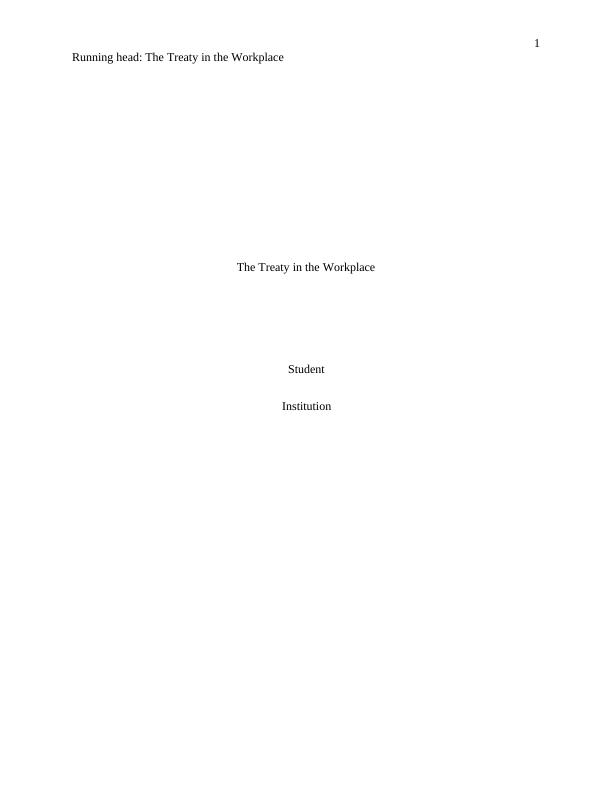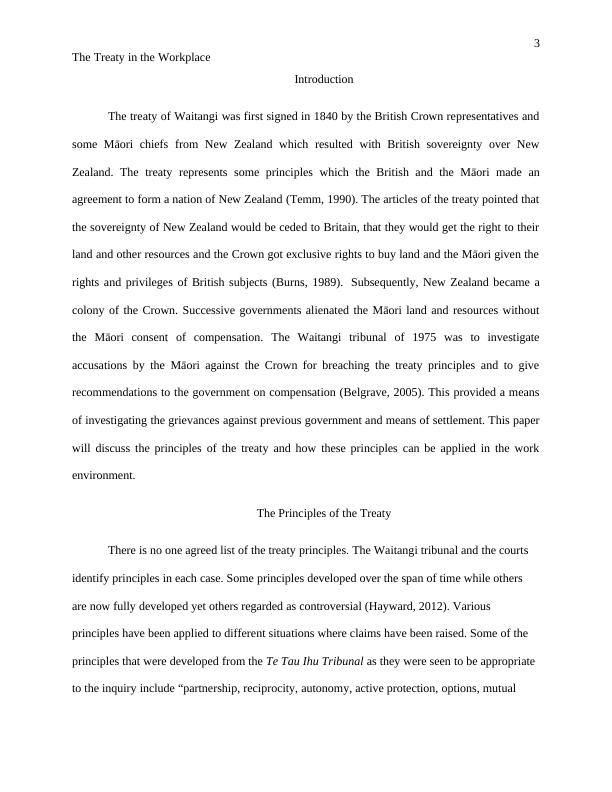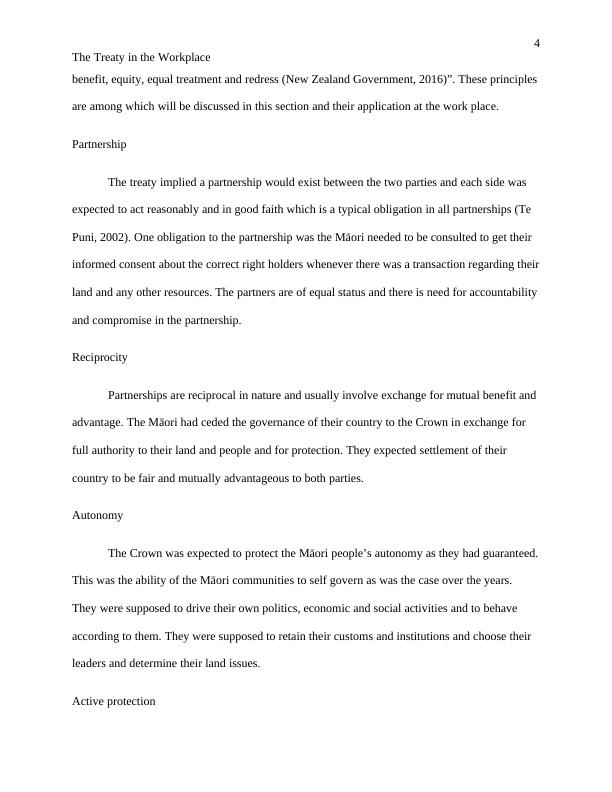Ask a question from expert
The Treaty in the Workplace - Desklib
12 Pages2617 Words183 Views
Added on 2020-04-01
The Treaty in the Workplace - Desklib
Added on 2020-04-01
BookmarkShareRelated Documents
1Running head: The Treaty in the WorkplaceThe Treaty in the WorkplaceStudent Institution

2The Treaty in the WorkplaceTable of ContentsIntroduction .................................................................................................. 3The Principles of the Treaty................................................................................. 3Partnership ............................................................................................4Reciprocity ...........................................................................................4Autonomy ............................................................................................4Active protection ....................................................................................4Options ................................................................................................5Mutual Benefit .......................................................................................5Equity ..................................................................................................6Equal Treatment .....................................................................................6Redress ............................................................................................... 6Application of the Principles at the Work Place ......................................................... 7Conclusion .....................................................................................................9References ....................................................................................................11

3The Treaty in the WorkplaceIntroductionThe treaty of Waitangi was first signed in 1840 by the British Crown representatives andsome Māori chiefs from New Zealand which resulted with British sovereignty over NewZealand. The treaty represents some principles which the British and the Māori made anagreement to form a nation of New Zealand (Temm, 1990). The articles of the treaty pointed thatthe sovereignty of New Zealand would be ceded to Britain, that they would get the right to theirland and other resources and the Crown got exclusive rights to buy land and the Māori given therights and privileges of British subjects (Burns, 1989). Subsequently, New Zealand became acolony of the Crown. Successive governments alienated the Māori land and resources withoutthe Māori consent of compensation. The Waitangi tribunal of 1975 was to investigateaccusations by the Māori against the Crown for breaching the treaty principles and to giverecommendations to the government on compensation (Belgrave, 2005). This provided a meansof investigating the grievances against previous government and means of settlement. This paperwill discuss the principles of the treaty and how these principles can be applied in the workenvironment.The Principles of the TreatyThere is no one agreed list of the treaty principles. The Waitangi tribunal and the courts identify principles in each case. Some principles developed over the span of time while others are now fully developed yet others regarded as controversial (Hayward, 2012). Various principles have been applied to different situations where claims have been raised. Some of the principles that were developed from the Te Tau Ihu Tribunal as they were seen to be appropriate to the inquiryinclude “partnership, reciprocity, autonomy, active protection, options, mutual

4The Treaty in the Workplacebenefit, equity, equal treatment and redress (New Zealand Government, 2016)”. These principlesare among which will be discussed in this section and their application at the work place.PartnershipThe treaty implied a partnership would exist between the two parties and each side was expected to act reasonably and in good faith which is a typical obligation in all partnerships (Te Puni, 2002).One obligation to the partnership was the Māori needed to be consulted to get their informed consent about the correct right holders whenever there was a transaction regarding theirland and any other resources. The partners are of equal status and there is need for accountabilityand compromise in the partnership.Reciprocity Partnerships are reciprocal in nature and usually involve exchange for mutual benefit and advantage. The Māori had ceded the governance of their country to the Crown in exchange for full authority to their land and people and for protection. They expected settlement of their country to be fair and mutually advantageous to both parties. AutonomyThe Crown was expected to protect the Māori people’s autonomy as they had guaranteed.This was the ability of the Māori communities to self govern as was the case over the years. They were supposed to drive their own politics, economic and social activities and to behave according to them. They were supposed to retain their customs and institutions and choose their leaders and determine their land issues. Active protection

End of preview
Want to access all the pages? Upload your documents or become a member.
Related Documents
The Principles of the Treaty of Waitangi and their Relevance to New Zealand Societylg...
|7
|1726
|313
The Principles of the Treaty of Waitangi and their Relevance to New Zealand Societylg...
|8
|1823
|299
The Waitangi Tribunallg...
|10
|3299
|77
The Treaty of Waitangi and Early Childhood Educationlg...
|9
|2116
|214
Workplace Culture and Compliant Behaviourslg...
|27
|868
|91
Court of Appeal’s Incorporation of the Principles of Waitangi in the Decision on NZ Maori Council Vs Attorney Generallg...
|6
|1370
|186